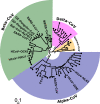The Origin of COVID-19 and Why It Matters
- PMID: 32700664
- PMCID: PMC7470595
- DOI: 10.4269/ajtmh.20-0849
The Origin of COVID-19 and Why It Matters
Abstract
The COVID-19 pandemic is among the deadliest infectious diseases to have emerged in recent history. As with all past pandemics, the specific mechanism of its emergence in humans remains unknown. Nevertheless, a large body of virologic, epidemiologic, veterinary, and ecologic data establishes that the new virus, SARS-CoV-2, evolved directly or indirectly from a β-coronavirus in the sarbecovirus (SARS-like virus) group that naturally infect bats and pangolins in Asia and Southeast Asia. Scientists have warned for decades that such sarbecoviruses are poised to emerge again and again, identified risk factors, and argued for enhanced pandemic prevention and control efforts. Unfortunately, few such preventive actions were taken resulting in the latest coronavirus emergence detected in late 2019 which quickly spread pandemically. The risk of similar coronavirus outbreaks in the future remains high. In addition to controlling the COVID-19 pandemic, we must undertake vigorous scientific, public health, and societal actions, including significantly increased funding for basic and applied research addressing disease emergence, to prevent this tragic history from repeating itself.
Conflict of interest statement
Disclosure: The views in this article are those of the authors and not of their institutions, or the NIAID, NIH, DHHS.
Figures


References
-
- Ksiazek TG, et al. 2003. A novel coronavirus associated with severe acute respiratory syndrome. N Engl J Med 348: 1953–1966. - PubMed
MeSH terms
Grants and funding
LinkOut - more resources
Full Text Sources
Other Literature Sources
Research Materials
Miscellaneous

